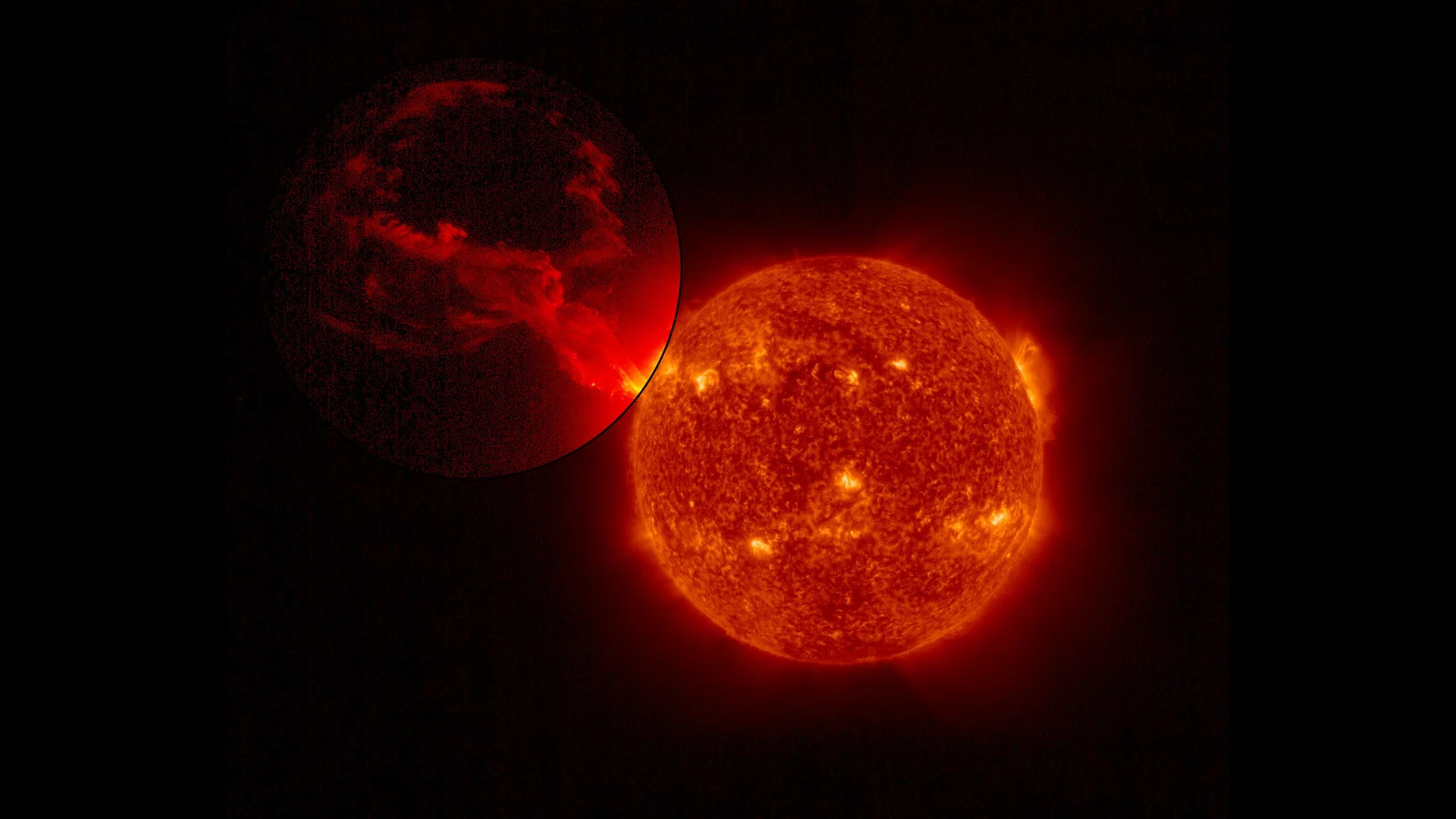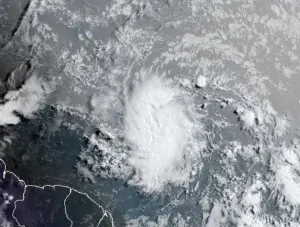
Solar Orbiter treats us to a rare view of a massive eruption from the Sun
This is the largest solar eruption ever observed in a single image together with the full disc of the Sun.
The European Space Agency's Solar Orbiter spacecraft has given us a unique look at a giant solar prominence that erupted from the Sun.
On February 15, 2022, satellites monitoring solar activity detected a massive eruption blasting out from the Sun. As it stretched for millions of kilometres out into space, this solar prominence was captured by several different instruments.
NASA's Solar Dynamics Observatory (SDO) images the entire disc of the Sun, watching for sunspots, solar flares, coronal mass ejections, and other activity. It caught the first moments of the event, revealing that the origin point was just beyond the eastern limb of the Sun, out of our direct view from Earth. However, while it gave us some hints about the size and shape of the eruption, the expanding prominence quickly left the instrument's field of view.

The Feb 15 solar prominence eruption is visible to the top left of the five frames shown here, as imaged by NASA SDO using its 304 Angstrom filter, which views the extreme ultraviolet light emanating from the Sun. Credit: NASA/SDO/GSFC/Scott Sutherland
The NASA/ESA Solar and Heliospheric Observatory (SOHO) picked up the eruption from there, tracking it with the LASCO coronagraph. This instrument uses a small disc to block direct light from the Sun from entering the camera, allowing it to image activity around the Sun.

This image combines a narrow-field C2 view (left, red) with a wide-field C3 view (right, blue) from SOHO's LASCO coronagraph. The solar prominence eruption is visible towards the top left of each frame. The left frame shows it nearly 2 hours after it began, with the right frame revealing its progress 3 hours later. The blank circle in the centre of each view is caused by the coronagraph disc, with the white ring denoting the Sun's location behind the disc. Credit: ESA/NASA/SOHO/Scott Sutherland
With SOHO's LASCO instrument specifically designed to block out the disc of the Sun, it could never capture both the Sun and a prominence like this in the same image.
SDO's instruments are only intended to focus on the Sun's disc, so it doesn't get LASCO's wide-field view. So, while it has captured a few fantastic views of prominences in the past, once they expand far enough away from the Sun's surface, the spacecraft loses sight of them.
However, one spacecraft — the ESA's Solar Orbiter — managed to capture a view of this prominence that SDO and SOHO could never get.

The February 15, 2022, solar prominence eruption, as imaged by the Full Sun Imager (FSI) of the Extreme Ultraviolet Imager (EUI) on the ESA's Solar Orbiter. Credit: Solar Orbiter/EUI and SOHO/LASCO teams, ESA & NASA
As the name implies, Solar Orbiter's 'Full Sun Imager' is a camera designed to take images of the full solar disc as the spacecraft flies around the Sun. The Sun fills a much larger portion of the view when Solar Orbiter reaches its closest distance (perihelion). However, it was much farther out at the time of this eruption. Thus, the sensitive instrument captured both the Sun's disc and millions of kilometres of the erupting prominence in the same image.
According to the ESA, "Solar prominences are large structures of tangled magnetic field lines that keep dense concentrations of solar plasma suspended above the Sun's surface, sometimes taking the form of arching loops. They are often associated with coronal mass ejections, which if directed towards Earth, can wreak havoc with our technology and everyday lives."
Watch below: Solar Orbiter and SOHO's view of a giant eruption
Coronal mass ejections are essentially solar prominences that have detached from the Sun's surface. CMEs form clouds of charged solar particles, often called solar storms, that expand as they sweep out into the solar system. If a CME sweeps past Earth, the cloud's magnetic field interacts with the planet's magnetic field, often resulting in a geomagnetic storm. These storms are known to produce bright aurora displays, and they can impact orbiting spacecraft and Earth-based power grids, causing outages and blackouts.
The ESA said that the coronal mass ejection that resulted from this prominence eruption was not directed at Earth. Forecasters from NOAA's Space Weather Prediction Center confirmed this, which meant that it would not affect Earth. According to the SWPC, any increased aurora activity over the past week has been due to changes in the solar wind.










